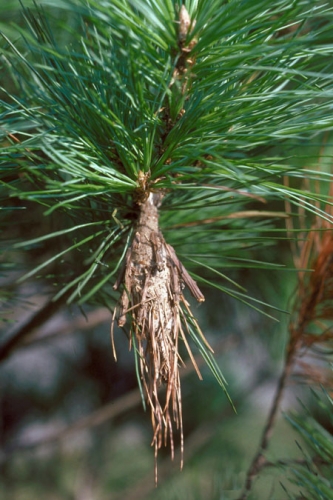Bagworms becoming more common in Michigan?
Bagworms can be found on plants year-round, but often go unnoticed until plants are defoliated. Now is a great time of the year to inspect conifers for bagworms.
While in Michigan’s Monroe County in early November, I met with Jenny Stanger, a retired colleague from MSU Extension. She asked if I had ever seen a bagworm infestation. Thinking back almost 30 years, I had seen bagworms on arborvitae a few times, but with only one or two bags per plant. This insect is more commonly found south of Michigan where populations can grow to large levels and defoliate plants. She showed me a 15-foot white pine in front of the Monroe County Extension office, covered by hundreds of brown bags made from needles. They almost look like small pine cones. The bagworms build these bags to protect them while they feed during the summer and later in the season the bags provide protection for their eggs through the winter.
|
Bagworms, Thyridopteryx ephemeraeformis, are known to feed on more than 120 species of trees and shrubs. This includes all species of Christmas trees and conifers, as well as many deciduous plants found in Michigan landscapes. The pine outside the office in Monroe was very sparse from the feeding that occurred last summer. Hundreds of bags covered the tree, each bag containing 300 to 1,000 eggs.
A group of Master Gardeners at the Monroe office that day took on the task of removing every egg sac they could reach, giving this pine tree a chance to survive for another season. Bags measure 1.5 to 2.5 inches in length and are often mistaken for cones when found on conifers.
Bagworms are small caterpillars that surround themselves with plant material, creating a bag-like structure that protects them as they feed on leaf tissue. Feeding lasts 8 to 10 weeks as larvae grows. At the end of the season, the caterpillars change into moths, mate and then die. The eggs survive the winter within the carcass of the female protected by the bag she built over the summer. Though this insect is a moth, the female never develops wings. The female moves from plant to plant by crawling or by “ballooning.” Ballooning occurs while the caterpillars are very young and tiny. The small larvae hanging by silk threads are blown by the wind to new plants. They can also be transported to new landscapes when infested plants are moved from other locations.
This is a great time of the year to inspect conifers for bagworms. Whether found in the landscape or in a nursery, the first step would be to pick the bags off the trees, which eliminates up to 1,000 eggs per bag, reducing the potential for damage late next spring. Penn State University has reported that young larvae begin to emerge when growing degree days reach 650 to 750. MSU’s Enviro-weather website provides average degree day charts showing that 650 to 750 occurs in Lower Michigan in mid-June. A biological control such as Bt (Bacillus thuringiensis) would be effective on very young larvae as they first emerge.
For more information on control measures, read the following fact sheets:
- Bagworms on Landscape Plants, University of Kentucky
- Woody Ornamental IPM: Bagworm, Penn State University
Related MSU Extension News article:
- Bagworms extend their reach northward, Howard Russell, MSU Diagnostic Services
Whether we see more of this insect in the future I cannot say for certain. Just this past summer, Howard Russell from Michigan State University Diagnostic Services reported the defoliation of a few Norway maples due to bagworms in Romulus, just west of Detroit. Bagworms do not move quickly into a landscape and, if caught early, damage to landscape and nursery plants can be prevented.



 Print
Print Email
Email





